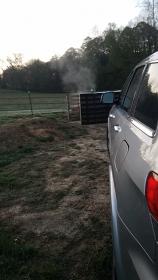Yes, I post a lot, sorry in advance, I get bored and no one at home ponders these things like I do, or even wants to discuss them, sigh…
So, thanks to Fb marketplace, Craigslist and my little spreader, I am starting from scratch with the manure/compost bin filling up and managing again, woohoo!!
Now I want to manage it correctly, but it will have to be turned by hand, no tractor or large equipment available. How is this done? Old school metal pitchfork? A shovel and a new shoulder and back ever month or so? How often do you do it? With my two, a 5.5 ft wide x 8 or so ft deep compost area is filled up in about 2 months. Should I try to keep it all on one side of that 5x8 area, so essentially 2to3ftx4ft, and then shovel/push it over to the other side? Like start at the top and letting that fall to the ground and build the pile back up basically opposite? Or pile the pile more towards the front and then shovel it towards the back to turn it? Or do people just use a metal old school fork and just move it around and turn it manually as much as you can?
Trying to keep it turned and cooking somewhat properly and avoid a charcoaled middle and still raw outer layer like I had this past March, literally looked like coals when I dug it out some when the steaming scared me one morning. I do have it tarped securely now and it stays covered 24/7 vs just being there uncovered like my previous pile. I only have room for 2 5ftwide by 8ft deep sections to rotate and use, so no 3 bin option for now either.
I do NOT want to shovel it all into a muck tub, one tub at a time or even my little jd dump cart, just to pile it back up in the other 5ishx8 area section of my compost bin. I am also trying to avoid spreading it with my spreader, (even though it is so fun to use!!) until it is cooked and the weed seeds and parasites are killed off completely. I don’t mind keeping the piles smaller than the allotted area to make turning it and cooking and spreading it faster and easier. Just wondering how those of you who do not have a tractor and FEL available, how DO you do turning and managing your manure piles?
I should mention I am on small acreage, 3.6ish but have a creek on one side so I try to be cognizant of that with manure management and fencing, runoff, etc.



